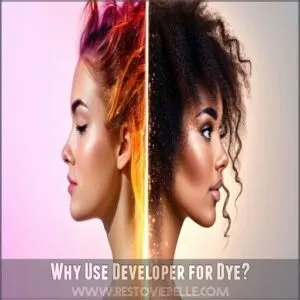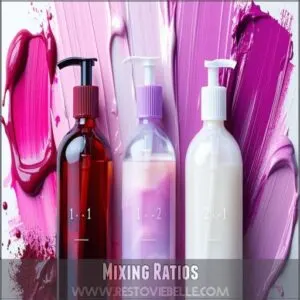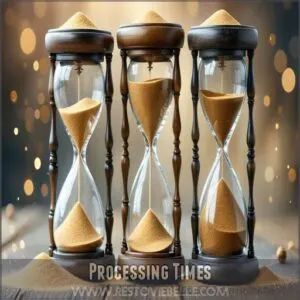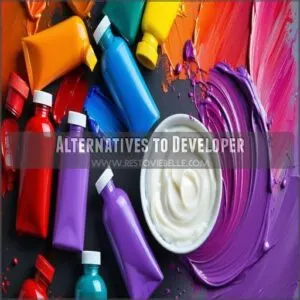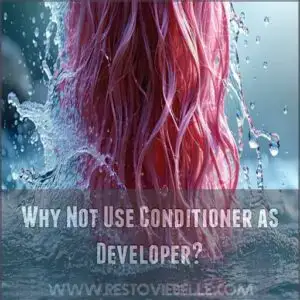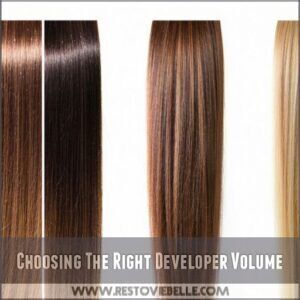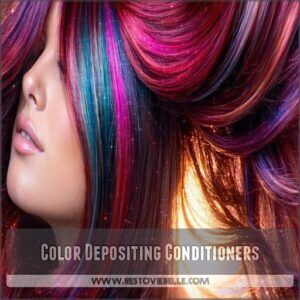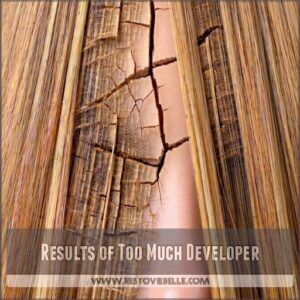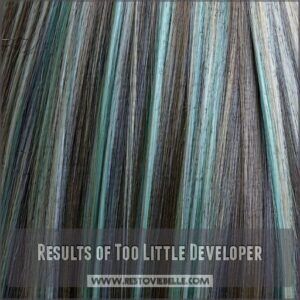This site is supported by our readers. We may earn a commission, at no cost to you, if you purchase through links.
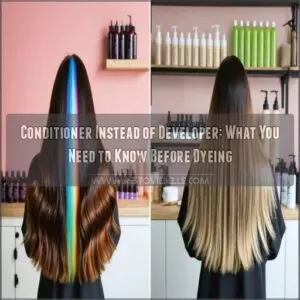 Using conditioner instead of developer might sound tempting, but it’s like trying to bake a cake without heat—it just won’t turn out right. Developer contains hydrogen peroxide, which is essential for opening your hair cuticle and activating the dye.
Using conditioner instead of developer might sound tempting, but it’s like trying to bake a cake without heat—it just won’t turn out right. Developer contains hydrogen peroxide, which is essential for opening your hair cuticle and activating the dye.
Conditioner, on the other hand, is only designed to moisturize and can leave you with splotchy, uneven color at best, or no change at all.
If you’re hoping for bold, lasting results, skipping the developer is a no-go. Instead, consider semi-permanent dyes or color-depositing conditioners for gentle alternatives without permanent commitment.
After all, a good hair day’s worth doing right!
Table Of Contents
- Key Takeaways
- Why Use Developer for Dye?
- How to Properly Use Developer
- Can I Skip Developer Completely?
- Alternatives to Developer
- Why Not Use Conditioner as Developer?
- Choosing The Right Developer Volume
- Using Conditioner After Dyeing
- Results of Too Much Developer
- Results of Too Little Developer
- When to Call a Professional
- Frequently Asked Questions (FAQs)
- What can I use instead of developer?
- What happens if you don’t use hair developer?
- Will mixing conditioner with hair dye make it lighter?
- Does conditioner stop hair dye from working?
- Can I mix developer with semi-permanent dye?
- Does damaged hair react differently to developer?
- How does developer affect bleach-only applications?
- Is there a natural way to replicate developer effects?
- What happens if developer touches my scalp?
- Conclusion
Key Takeaways
- You can’t use conditioner instead of developer—it won’t activate the dye, leading to patchy or nonexistent results.
- Developer opens your hair cuticle and triggers chemical reactions essential for bold, lasting color.
- Mixing conditioner with dye only dilutes the pigment, creating lighter but temporary effects without permanent color payoff.
- If you’re skipping developer, semi-permanent dyes or color-depositing conditioners are safer alternatives for gentle, temporary color changes.
Why Use Developer for Dye?
You can’t skip the developer if you want your hair dye to actually work.
It’s the secret behind activating the color and helping it soak into your strands for lasting results.
Activates Dye
Using a developer is what makes hair dye work its magic. Without it, the color just doesn’t stick—it’s like baking bread without yeast.
Developer triggers the oxidation process, releasing the dye’s full potential through chemical reactions. This is what gives you bold, permanent color and guarantees proper color enhancement.
It also starts the hair lightening process, so darker shades can transform. Skipping it or attempting conditioner instead of developer? That’s a hair dye disaster waiting to happen.
Developer substitutes just can’t ignite the chemical reactions needed for dye activation, leaving your color patchy, weak, or non-existent—and nobody wants that!
Allows Dye to Penetrate
The magic of vibrant color lies in dye penetration, and that’s where the developer works its charm.
It opens up your hair cuticle, letting the color seep in for full absorption. Without it, using conditioner instead of developer leaves the dye sitting on the surface, giving dull or patchy results.
Think of it like painting a wall without primer—it just won’t stick right. Using the right conditioners to mix can also impact the final color outcome.
For proper hair dye penetration, stick to the right developer ratio every time!
How to Properly Use Developer
When you’re ready to transform your hair color, understanding how to use developer is your first step to salon-worthy results.
You’ll want to mix your developer and dye carefully, following the right ratios and processing times to achieve the perfect color without damaging your locks.
Mixing Ratios
Want hair color magic without the mishaps? Mastering dye concentration is your secret weapon. Here’s the lowdown on developer ratios:
- Permanent dye: 1:1 magic potion
- Bleach: 1 part powder to 2 parts developer
- Toner: 1:2 color alchemy
Precision matters more than guesswork. Eyeballing measurements is like driving blindfolded – dangerous and unpredictable. Stick to the formula, and you’ll dodge hair color catastrophes like a pro.
Processing Times
After mixing your dye and developer, watch the clock like a hawk.
| Developer Volume | Processing Time | Color Magic |
|---|---|---|
| 10 Volume | 10-20 min | Whisper of change |
| 20 Volume | 20-30 min | Noticeable transformation |
| 30 Volume | 30-45 min | Bold color shift |
Each volume demands its own dance with time. Cross the line, and you’ll risk frying your locks. Always follow product instructions – your hair’s survival depends on it.
Can I Skip Developer Completely?
Wondering if you can ditch the developer and dodge potential hair damage? Color depositing conditioners might be your secret weapon.
These gentle alternatives coat your hair shaft, delivering subtle color without peroxide’s harsh bite. But here’s the catch: your results won’t pack the same punch as traditional dyes.
You’ll trade vibrant, long-lasting color for a softer, more temporary transformation. If gray coverage and dramatic shade changes aren’t your top priority, conditioner-based colors could be your hair’s new best friend.
Just remember: liberation comes with compromise – less drama, more hair health.
Alternatives to Developer
If you’re looking to switch up your hair color without the hassle of traditional permanent dye, you’ve got some awesome alternatives.
Semi-permanent dyes and hair wax can give you a fresh look without the commitment of permanent color, letting you experiment and have fun with your style.
Semi-Permanent Dye
Skipping the harsh chemicals? Semi-permanent dyes are your hair’s best friend for a pigment refresh without the developer drama. These direct dye applications slide right onto your locks, depositing color that’ll make heads turn—minus the peroxide punch.
Perfect for those wanting to test-drive a new shade without commitment, semipermanent hair dye lets you experiment freely.
When considering semi permanent hair options, it’s key to understand the benefits and application process. The color won’t last forever, but it’ll give your hair a vibrant makeover that fades gracefully, keeping your strands happy and healthy.
Hair Wax
Looking to jazz up your hair without the harsh peroxide? Hair wax offers a fun, temporary color solution that’s both stylish and kind to your locks. For best results, explore hair wax products that condition and color your hair.
- Swipe on vibrant colors that wash out in a snap
- Condition and color your hair in one smooth move
- Transform your look without long-term commitment
Wax gives you the freedom to play with color, adding glossy texture and personality to your style—no permanent consequences attached.
Why Not Use Conditioner as Developer?
When hair dye meets conditioner instead of developer, it’s like bringing a butter knife to a construction site.
Developer’s chemical choreography is vital—peroxide lifts hair cuticles, allowing pigments to penetrate deeply.
Substituting conditioner triggers a color catastrophe: pigments won’t bind, leading to rapid Color Fading and Hair Damage Risk.
Understanding the role of Hair Dye is essential for a successful dye job.
The pH Balance gets disrupted, causing Nutrient Loss and compromising your hair’s structural integrity.
Without proper Chemical Reactions, your vibrant color dreams will literally wash down the drain.
Pro tip: Respect the science.
Use developer as directed, and save that luxurious conditioner for post-dye pampering.
Your locks will thank you.
Choosing The Right Developer Volume
In the context of hair dye, choosing the right developer volume is like picking the perfect dance partner for your color transformation.
You’ll want to match the volume to your hair’s needs, ensuring you get the color you want without causing unnecessary damage, which involves finding the right color transformation.
Developer Volume Strengths
Your hair color journey starts with picking the right developer volume.
A 10 or 20 vol developer lets you safely enhance your natural shade without going nuclear.
Pro tip: Higher volumes mean more lift but also more damage risk.
Think of developer volumes like spice levels – start mild and work your way up carefully to avoid scorching your strands.
Conditioner Vs. Developer
Let’s cut to the chase: conditioner and developer are like oil and water in the context of hair color.
While conditioner moisturizes and protects, it can’t trigger the chemical reactions needed for permanent dye.
Skipping developer leads to color fading, uneven application, and potential hair breakage.
Your dream shade requires the real deal – no shortcuts allowed.
Avoiding Damage From Peroxide
Peroxide packs a punch that can turn hair transformation into a hair nightmare if you’re not careful. While swapping conditioner for developer might seem tempting, it’s a shortcut to damage city.
Protect your locks from the harsh chemical rollercoaster with these smart moves: To achieve the best results and minimize damage, consider following a hair bleaching guide.
- Dilute peroxide carefully to minimize hair breakage
- Opt for gentle, low-volume formulas that whisper instead of scream
- Test a strand first to dodge potential color catastrophes
Using Conditioner After Dyeing
After dyeing your hair, you’ll want to keep those vibrant locks looking healthy and glossy with the right conditioning routine.
Color-depositing conditioners can help you maintain your fresh color while giving your hair the moisture and protection it craves.
Moisturizing and Protecting
After battling harsh developer chemicals, your hair craves some serious TLC.
Rescue your color-treated locks with a weekly hair mask packed with shea butter, coconut oil, and argan oil. Think of it as a spa day for your strands.
Spritz on a lightweight conditioning spray daily to shield your color and keep those locks looking luscious. Your hair’s survival kit? Hydration, protection, and a whole lot of love.
Color Depositing Conditioners
Looking to amp up your hair color without breaking out the developer? Color depositing conditioners are your secret weapon! These magical hair toners give you a color boost while keeping your locks silky smooth.
Check out why they’re a game-changer:
- Deposit vibrant tints instantly
- Correct shade variations
- Lock in existing color
- Protect hair from damage
- Provide deep conditioning
Using a Color Depositing product can be beneficial for maintaining your hair’s color and health. Want to keep your color looking fresh between salon visits? These color enhancers work like a charm, giving you professional-grade results right in your shower. No harsh chemicals, just pure color magic!
Results of Too Much Developer
Ever wondered why your DIY hair color went sideways? Too much developer can be a hair nightmare. Let’s break down the risks of overdoing it: Understanding the correct hair color developer ratio is essential to avoid damage.
| Volume | Risk Level | Potential Damage |
|---|---|---|
| 10 | Low | Minimal color shift |
| 20 | Medium | Slight cuticle opening |
| 30 | High | Significant hair stress |
| 40 | Extreme | Severe breakage possible |
Pumping up the developer volume is like playing Russian roulette with your locks. Higher volumes blast open hair cuticles, leading to dryness, brittleness, and potential scalp burns. Your hair craves balance – not a chemical assault. Stick to the right volume, deep condition religiously, and save your strands from a color catastrophe.
Results of Too Little Developer
Skimp on developer, and you’ll end up with a hair color disaster that looks more like a patchy DIY experiment gone wrong. Using too little developer means your hair dye won’t fully activate, leaving you with faded hair color, dry hair damage, and a dull finish that screams "I tried to cut corners."
Understanding the correct mixing ratios is vital to avoid such mistakes. Color inconsistency becomes your new enemy, with stubborn grays peeking through like unwelcome guests at a party.
When you dilute the developer or choose a weak volume, you’re basically telling your hair dye to do half a job. The result? Hair breakage, uneven color, and a far cry from the vibrant look you were hoping for. Your hair deserves better than a conditioner substitute – mix that developer right and watch the magic happen.
When to Call a Professional
Someone facing a hair dye disaster needs to know when it’s time to wave the white flag and call in the pros. Professional colorists are your hair’s best friends when DIY goes wrong.
Understanding how to prevent scalp issues is essential for a successful coloring process.
- Uneven color that looks like a patchwork nightmare
- Severe hair damage from chemical mishaps
- Unexpected brassy or muddy color tones
- Complex color correction beyond home remedies
Hair colorists bring years of expertise to rescue your locks from potential disaster. They’ll assess your hair’s condition, recommend the right treatments, and transform your color catastrophe into a stunning makeover. Don’t let pride or budget fears keep you from professional help – sometimes, spending a bit more saves your hair’s health and your confidence.
Frequently Asked Questions (FAQs)
What can I use instead of developer?
If you’re out of developer, diluted 3% hydrogen peroxide can work in a pinch.
Natural options like lemon juice, chamomile tea, or henna might help, but don’t expect bold, lasting color with these.
What happens if you don’t use hair developer?
Skipping developer is like baking a cake without heat—your hair color won’t stick or process properly.
The color may appear patchy, fade quickly, or not show up at all, wasting your effort entirely.
Will mixing conditioner with hair dye make it lighter?
Mixing conditioner with hair dye can dilute the pigment, creating a lighter, pastel-like color.
It won’t lift or lighten your hair, though, because conditioner doesn’t have the peroxide power that a developer provides.
Does conditioner stop hair dye from working?
Conditioner can clog the color process, creating chaos for your dye job.
It doesn’t open the hair cuticle like developer does, so your color might turn out patchy, muted, or fade faster than you’d like.
Can I mix developer with semi-permanent dye?
You don’t need developer with semi-permanent dye since it works by coating your hair, not penetrating it. Understanding hair dye chemistry is key to achieving the desired color.
Mixing them won’t help and might dilute the color, leaving you with disappointing, uneven results.
Does damaged hair react differently to developer?
Think of damaged hair like a beaten-up sponge—it soaks up developer unevenly, leading to patchy color or excessive lifting.
With weaker structure, it’s also more prone to breakage, so handle with extra care and low volumes.
How does developer affect bleach-only applications?
Developer activates bleach by opening your hair’s cuticle and breaking down melanin, allowing lightening to happen.
Skipping it’s like making pancakes without heat—nothing happens.
The stronger the developer, the lighter the hair gets (with risks).
Is there a natural way to replicate developer effects?
Ever wonder if nature holds the secret to hair coloring?
Lemon juice, black tea, or chamomile can mimic subtle developer effects.
They’re gentle and natural but won’t pack the punch of a true salon-grade developer.
What happens if developer touches my scalp?
If developer touches your scalp, it might tingle or burn slightly, especially if you have sensitive skin.
Always do a patch test first, and don’t leave it on longer than recommended to avoid irritation.
Conclusion
Did you know that over 75% of people who try DIY hair dye end up Googling what went wrong?
Using conditioner instead of developer isn’t a hack—it’s a recipe for uneven, disappointing color. Developer activates the dye, making it stick and last, while conditioner just moisturizes.
If you’re after serious results, don’t skip the science. Stick to developer or explore safe alternatives like semi-permanent dyes.
Hair DIYs should be fun, not frustrating—do it right the first time!
- https://www.reddit.com/r/HaircareScience/comments/bes574/diluting_developer_with_conditioner/
- https://theglossylocks.com/conditioner-instead-of-developer/
- https://www.coloredhaircare.com/conditioner-instead-of-developer/
- https://hairsentry.com/use-conditioner-instead-developer/
- https://www.curlcentric.com/can-you-use-conditioner-as-developer/

